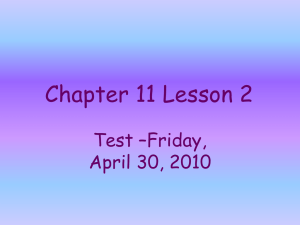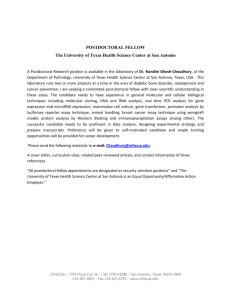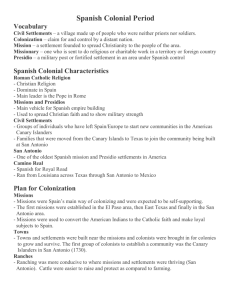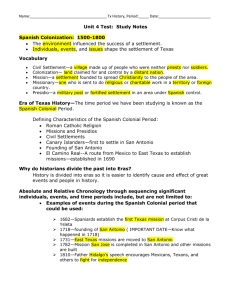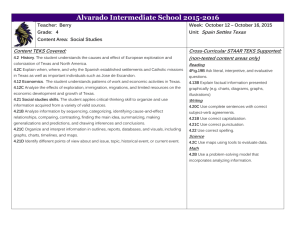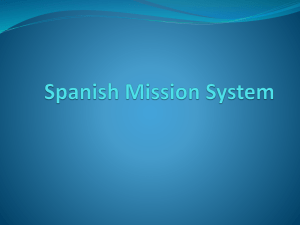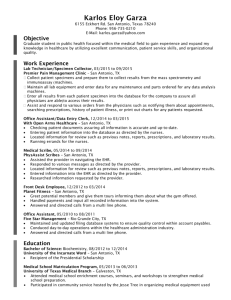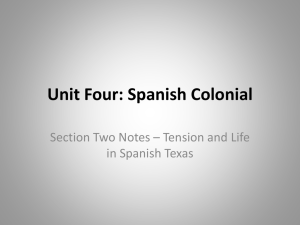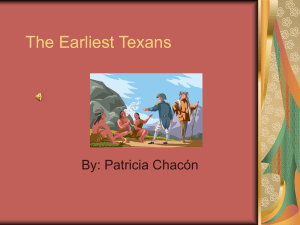Name: Tx History, Period:_____ Date: Unit 4 Test: Study Notes
advertisement
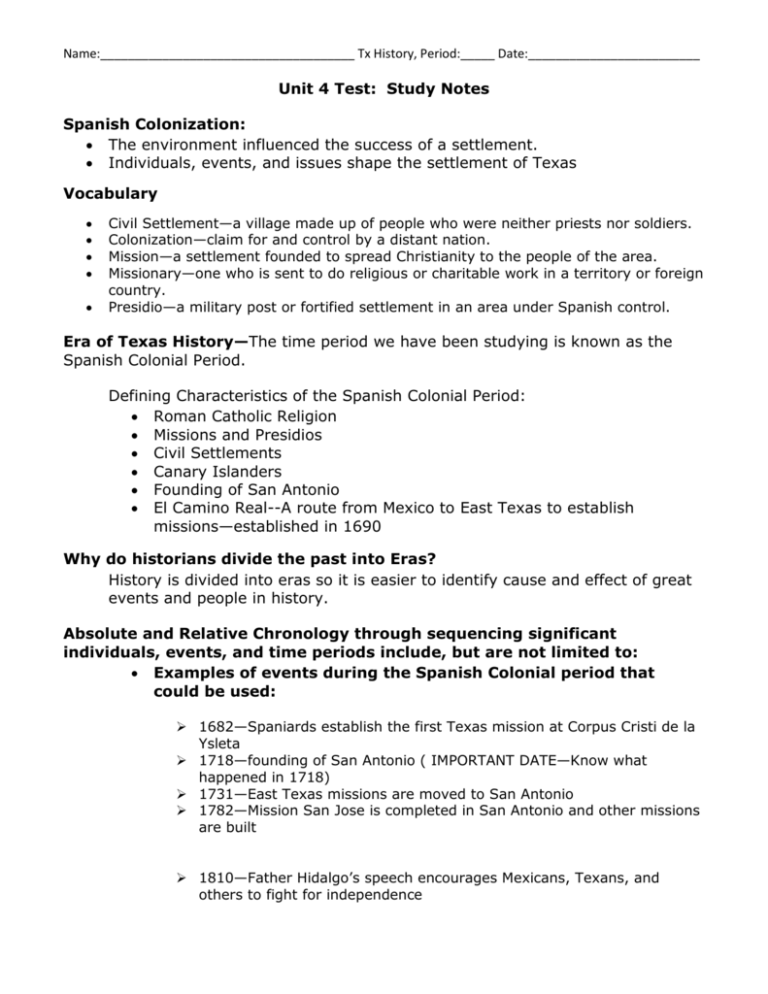
Name:_____________________________________ Tx History, Period:_____ Date:_________________________ Unit 4 Test: Study Notes Spanish Colonization: The environment influenced the success of a settlement. Individuals, events, and issues shape the settlement of Texas Vocabulary Civil Settlement—a village made up of people who were neither priests nor soldiers. Colonization—claim for and control by a distant nation. Mission—a settlement founded to spread Christianity to the people of the area. Missionary—one who is sent to do religious or charitable work in a territory or foreign country. Presidio—a military post or fortified settlement in an area under Spanish control. Era of Texas History—The time period we have been studying is known as the Spanish Colonial Period. Defining Characteristics of the Spanish Colonial Period: Roman Catholic Religion Missions and Presidios Civil Settlements Canary Islanders Founding of San Antonio El Camino Real--A route from Mexico to East Texas to establish missions—established in 1690 Why do historians divide the past into Eras? History is divided into eras so it is easier to identify cause and effect of great events and people in history. Absolute and Relative Chronology through sequencing significant individuals, events, and time periods include, but are not limited to: Examples of events during the Spanish Colonial period that could be used: 1682—Spaniards establish the first Texas mission at Corpus Cristi de la Ysleta 1718—founding of San Antonio ( IMPORTANT DATE—Know what happened in 1718) 1731—East Texas missions are moved to San Antonio 1782—Mission San Jose is completed in San Antonio and other missions are built 1810—Father Hidalgo’s speech encourages Mexicans, Texans, and others to fight for independence Name:_____________________________________ Tx History, Period:_____ Date:_________________________ Important events and issues related to European colonization of Texas: The establishment of Catholic missions, towns, and ranches Missions were Spain’s main way of colonizing and were expected to support themselves. The first missions were established in the El Paso area, then East Texas and finally in the San Antonio area. Missions were used to convert the native Texans to the Catholic faith and make loyal subjects to Spain. Towns—Towns and settlements were built near the missions and colonists were brought in for colonies to grow and survive. The first group of colonists to establish a community was the Canary Islanders in San Antonio (1730). Ranches—Ranching was more conducive to where missions and settlements were thriving (San Antonio). Cattle were easier to raise and protect than farming. Fray Damian Massanet Convinced the viceroy of New Spain to colonize East Texas and convert the Caddoes to Catholicism. 1690—Alonso De Leon and Massanet were sent with several priests and about 100 soldiers to colonize East Texas. Resulted in many missions in East Texas even though they were failures. Jose de Escandon (1750s) Military commander and governor of Nuevo Santander (present-day Laredo and surrounding area) Led Spain’s expansion effort in South Texas lands between the Rio Grande and Nueces River establishing missions, presidios, and settlements Moved La Bahia mission and presidio from the Guadalupe River to the present-day site of Goliad Antonio Margil de Jesus (early 1700s) Spanish Franciscan priest Founded several missions in East Texas including Nuestra Senora de los Dolores and San Miguel de los Adaes Due to the problems in East Texas, he moved to San Antonio and founded San Jose y San Miguel de Aguayo, one of the five missions in San Antonio today Francisco Hidalgo (early 1700s) Priest at Mission San Francisco de los Tejas Contacted French Catholic priests to provide religious services to the local native people when Spanish priests aren’t available Caused Spanish to be suspicious of French colonization Name:_____________________________________ Tx History, Period:_____ Date:_________________________ Maps: Spanish control in the Americas Texas Missions and Settlements Spanish Colonial: Where did the Spanish establish missions? Why? The first missions were established in the El Paso area, then East Texas and finally in the San Antonio area. Missions were used to convert the native Texans to the Catholic faith and make loyal subjects to Spain. Three purposes of the Mission-presidio System in Texas To keep the French in Louisiana out of Texas, Convert Native Americans of Texas to Christianity, Make the Native Americans loyal Spanish subjects. Ways Texans have adapted to and modified the environment: Colonial Homes—built from timber and rocks Dog Run Homes—built with a breezeway for shade and to catch the breeze Home furnishing—made from natural resources in the area Buckskin Clothes—made from deer hide Water Wells—built to acquire water near their home Food—killed animals and grew crops Name:_____________________________________ Tx History, Period:_____ Date:_________________________ Positive and Negative Consequences of the modifications to the environment: Spanish Colonial Consequences • Beginning the cattle industry in Texas, • Helping develop Texas's unique Tejano culture • Leaving behind three major settlements Spanish Influence on Texas Place Names: Amarillo—In Spanish means yellow. This was the color of the soil of the area and the beautiful wildflowers. Named by early settlers in this area Rio Grande—In Spanish it means “Big River” Many Texas rivers and landforms have Spanish names Vocabulary: Vaquero—Spanish word for cowboy Rodeo—A sport that is based on the skills of cowboys or vaqueros Religion: Roman Catholic Architecture Home-Hacienda Presidio-Fort Aceqias-wells (aquifer) Adobe—brick Arch—style of architecture Food: Tortillas—flat bread made of corn Tamales—Dumpling made of corn flour and meat Arts: Corridos—ballad Frescos—Mural painting found in Catholic churches Tejano Music—Music that originated from the cultural convergence of Spanish, German, Czech, and Polish music and instruments
